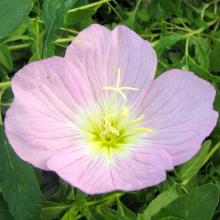Oenothera speciosa
Common name:
Showy evening primrose
Genus:
Oenothera
Family:
Onagraceae
Order:
Myrtales
Oenothera speciosa
Common name:
Showy evening primrose
Genus:
Oenothera
Family:
Onagraceae
Order:
Myrtales
Oenothera speciosa
Common name:
Showy evening primrose
Genus:
Oenothera
Family:
Onagraceae
Order:
Myrtales
Genus (Plantae): Oenothera
Oenothera is a genus of about 145 species of herbaceous flowering plants native to the Americas. It is the type genus of the family Onagraceae. Common names include evening primrose, suncups, and sundrops. They are not closely related to the true primroses (genus Primula).
Description
The species vary in size from small alpine plants 10 centimeters tall, such as O. acaulis from Chile, to vigorous lowland species growing to 3 meters, such as O. stubbei from Mexico. The leaves form a basal rosette at ground level and spiral up to the flowering stems. The blades are dentate or deeply lobed (pinnatifid). The flowers of many species open in the evening, hence the name "evening primrose". They may open in under a minute. Most species have yellow flowers, but some have white, purple, pink, or red. Most native desert species are white. Oenothera caespitosa, a species of western North America, produces white flowers that turn pink with age. One of the most distinctive features of the flower is the stigma, which has four branches in an X shape.
Ecology
Oenothera flowers are pollinated by insects, such as moths and bees. Like many other members of the Onagraceae, however, the pollen grains are loosely held together by viscin threads, so only insects that are morphologically specialized to gather this pollen can effectively pollinate the flowers. Bees with typical scopa cannot hold it. Also, the flowers open at a time when most bee species are inactive, so the bees which visit Oenothera are generally vespertine temporal specialists: bees that forage in the evening. The seeds ripen from late summer to fall.
Oenothera are used as food plants by the larvae of some Lepidoptera species, including the large white-lined sphinx (Hyles lineata). The flower moths Schinia felicitata and S. florida both feed exclusively on the genus, and the former is limited to O. deltoides.
In the wild, some species of evening primrose act as primary colonizers, quickly appearing in recently cleared areas. They germinate in disturbed soils, and can be found in habitat types such as dunes, roadsides, railway embankments, and waste areas. They are often casual and are eventually out competed by other species.
Based on observations of evening primroses (O. drummondii), a study discovered that within minutes of sensing the sound waves of nearby bee wings through flower petals, the concentration of the sugar in the plant's nectar was increased by an average of 20 percent. Experiments were also conducted on flowers with the petals removed. No change in nectar production was noted, indicating that it is indeed the flowers that have the job of the ears.
Taxonomy
Evening primroses were originally assigned to the genus Onagra, which gave the family Onagraceae its name. Onagra '[food of] onager' was first used in botany in 1587, and in English in Philip Miller's 1754 Gardeners Dictionary: Abridged. The modern name Oenothera was published by Carolus Linnaeus in his Systema Naturae. Its etymology is uncertain, but it is believed to be derived from the Greek words οίνος θήρα (oinos thera) 'wine seeker'.
The genus is divided into 18 sections and additionally into several subsections and series.
Dietary uses and side effects
Certain Oenothera plants have edible parts. The roots of O. biennis are reportedly edible in young plants. So are the flowers which have a sweet, crunchy taste.
The common evening primrose, O. biennis, is commonly sold as a dietary supplement in capsules containing the seed oil. The main phytochemical in this evening primrose seed oil is gamma-linolenic acid.
There is no high-quality scientific evidence that O. biennis or evening primrose oil has any effect on human diseases or promotion of health, and specifically no evidence that it is effective to treat atopic dermatitis or cancer. Research indicates that orally-administered evening primrose oil does not relieve symptoms of premenstrual syndrome, and does not have an effect on shortening the length of pregnancy or labor.
Consuming evening primrose oil may cause headache or stomach upset, may increase the risk of complications during pregnancy, and may increase the risk of bleeding in people given prescription drugs as anticoagulants, such as warfarin.
Reference: Wikipedia

